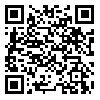BibTeX | RIS | EndNote | Medlars | ProCite | Reference Manager | RefWorks
Send citation to:
URL: http://tumj.tums.ac.ir/article-1-7837-en.html

 1, Shahin Gavanji2
1, Shahin Gavanji2 
 , Faezeh Khozimeh3
, Faezeh Khozimeh3 
 , Zahra Golestannejad3
, Zahra Golestannejad3 
 , Mohammadreza Golestannejad4
, Mohammadreza Golestannejad4 
 , Mahin Bakhshi5
, Mahin Bakhshi5 
 , Hazhir Yousefshahi6
, Hazhir Yousefshahi6 
 , Mohsen Doostmohammadi2
, Mohsen Doostmohammadi2 

2- Young Researchers and Elite Club, Isfahan (Khorasgan) Branch, Islamic Azad University, Isfahan, Iran.
3- Dental Research Center, Department of oral Medicine, School of Dentistry, Isfahan University of Medical Sciences, Isfahan, Iran.
4- Department of Orthopedic, Isa Ben Maryam Hospital, School of Medicine, Isfahan University of Medical Sciences, Isfahan, Iran.
5- Department of Oral and Maxillofacial Medicine, School of Dentistry, Shahid Beheshti University of Medical Sciences, Tehran, Iran.
6- Dental Student, Students Research Center, School of Dentistry, Isfahan University of Medical Sciences, Isfahan, Iran.
Background: Protective antigen of anthrax toxin, after touching the cell receptors, plays an important role in the pathogenesis of toxin. The purpose of this study was to investigate the interaction of anthrax toxin protective antigen and four great combination propolis included caffeic acid, benzyl caffeate, cinnamic acid and kaempferol using the softwares and bioinformatics web servers.
|
Methods: Three-dimensional structure of protective antigen (receptor) obtains from Protein Data Bank (PDB). Four of the main components from propolis were selected as ligand and their 3D-structures were obtained from ChemSpider and ZINC compound database. The interaction of each ligand and receptor was assessed by SwissDock server (http://www.swissdock.ch/) and BSP-SLIM server (http://zhanglab.ccmb.med.umich.edu/BSP-SLIM). Docking results appears with Fullfitness numbers (in kcal/mol). Identification of amino acids involved in ligand and receptor interaction, was performed using the Chimera software; UCSF Chimera program (http://www.cgl.ucsf.edu/). Results: The results of interaction between propolis components and protective antigen by BSP-SLIM server showed that the most interaction was related with benzyl caffeate, caffeic acid, kaempferol and cinnamic acid, respectively. Results for the desired ligand Interaction with protective antigen genes using SwissDock server showed that the caffeic acid had ΔG equals -9.10 kcal/mol and FullFitness equal to -993.16 kcal/mol respectively. The analysis of interaction between ligands with amino-acids of protective antigen indicated that the interaction of Caffeic acid whit Glutamic acid 117 had energy -15.5429 kcal/mol. Conclusion: Finding strong and safe inhibitors for anthrax toxin is very useful method for inhibiting its toxicity to cell. In this study the binding ability of four flavonoids to protective antigen was studied. Glutamic acid 117 is very effective in protective antigen binding and cell receptor and subsequent in virulent of anthrax toxin. Effective interaction of caffeic acid in propolis and glutamic acid 117 can be as useful in preventing the toxic effect on cell. According to our results, all four flavonoids tested in this study have binding activity to protective antigen and are good choices for fighting against anthrax. |
| Rights and permissions | |
 |
This work is licensed under a Creative Commons Attribution-NonCommercial 4.0 International License. |



